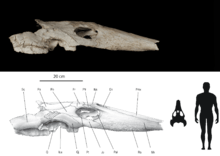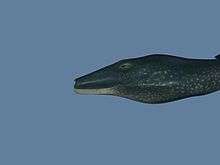Ocepechelon
| Ocepechelon Temporal range: Late Cretaceous, 67 Ma | |
|---|---|
 | |
| Skull and size comparison of Ocepechelon | |
| Scientific classification | |
| Kingdom: | Animalia |
| Phylum: | Chordata |
| Class: | Reptilia |
| Order: | Testudines |
| Suborder: | Cryptodira |
| Clade: | Americhelydia |
| Clade: | Dermochelyoidae |
| Family: | Dermochelyidae |
| Genus: | †Ocepechelon Bardet et al, 2013 |
| Type species | |
| †Ocepechelon bouyai Bardet et al, 2013 | |

Ocepechelon is an extinct genus of giant dermochelyoid sea turtle known from Late Cretaceous (late Maastrichtian stage, 67 Myr) Phosphatic deposits of the Oulad Abdoun Basin, Khouribga Province of Morocco. It is known from the holotype OCP DEK/GE 516, a complete but isolated 70-cm-long skull, making it one of the largest marine turtles ever described. It was first named by Nathalie Bardet, Nour-Eddine Jalil, France de Lapparent de Broin, Damien Germain, Olivier Lambert and Mbarek Amaghzaz in 2013 and the type species is Ocepechelon bouyai. The feeding apparatus of Ocepechelon, a bony pipette-like snout, is unique among tetrapods and shares unique convergences with both syngnathid fishes (unique long tubular bony snout ending in a rounded and forward directed mouth) and beaked whales (large size and elongated edentulous jaws).[1]
Phylogeny

Below is a cladogram from the 2013 description of Ocepechelon by Bardet et al (2013). Numerous methods were used to assess it phylogenetic position. The removal of outgroup taxa, except the hypothetical taxon, resolved some relations and found Ocepechelon and Bouliachelys to be basal dermochelyoids in a polytomy with the Dermochelyidae and the Protostegidae. The inclusion of Chelomacryptodira resolved this polytomy, and found Ocepechelon to be the most basal dermochelyid.[1]
| |
| ||||||||||||||||||||||||||||||||||||||||||||||||||||||||||||||||||||||||||||||||||||||||||
| |
References
- 1 2 Bardet, N.; Jalil, N. E.; De Lapparent De Broin, F.; Germain, D.; Lambert, O.; Amaghzaz, M. (2013). Viriot, Laurent, ed. "A Giant Chelonioid Turtle from the Late Cretaceous of Morocco with a Suction Feeding Apparatus Unique among Tetrapods". PLoS ONE. 8 (7): e63586. doi:10.1371/journal.pone.0063586.